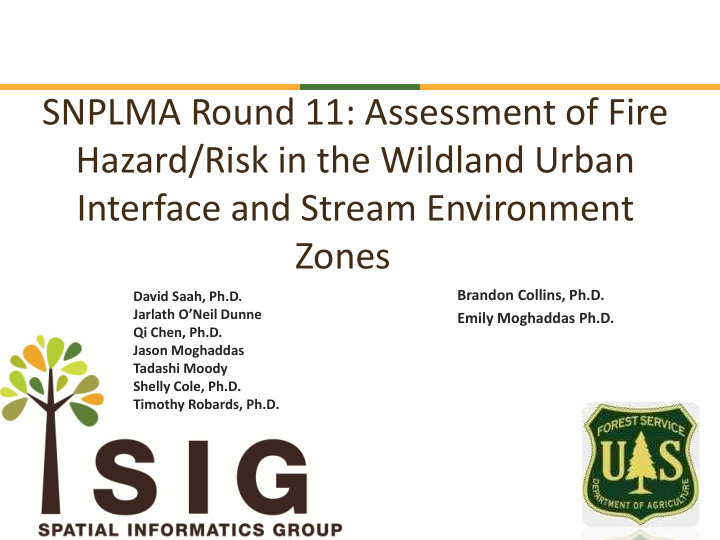



SNPLMA Round 11: Assessment of Fire Hazard/Risk in the Wildland Urban Interface and Stream Environment Zones ‖ Brandon Collins, Ph.D. David Saah, Ph.D. Jarlath O’Neil Dunne Emily Moghaddas Ph.D. Qi Chen, Ph.D. Jason Moghaddas Tadashi Moody Shelly Cole, Ph.D. Timothy Robards, Ph.D.
Key Research Question • Given existing and planned fuel treatments, what is the current and future potential for crown fire initiation and conditional burn probability in WUI and SEZ areas of the Lake Tahoe Basin?
Why?
Why?
Why?
It’s not snow…
Methods : Generate DTM, DSM, CHM • DTM: Digital Terrain Model • DSM: Digital Surface Model • CHM: Canopy Height Model DTM DSM CHM
Methods con’t : Individual Tree Mapping and Fuel Model Classification • Map individual tree locations, tree height, crown size, and vertical height distribution • Stem mapping and photos completed on 75 plots across the Basin • Additional 45 plots with site specific fuel model classification data collected for treated areas
Methods con’t : Define WUI; Compile and Map Existing and Planned Fuel Treatments • Draft map includes fuel treatment data provided by several Lake Tahoe Basin Agencies and Organizations • Need to make sure all known treatments are accounted for • Do our best to incorporate known planned treatments
Methods con’t : Vegetation Structure Layers • Generate raster layers to characterize the vertical and horizontal distributions of vegetation using LiDAR Data
Test Case: Ward Creek HUC 12 • ~19,000 Acres • 1,850 acres mapped as “riparian vegetation”
Ward Creek HUC 12 • ~19,000 Acres • 1,850 acres mapped as “riparian vegetation” • Existing fuel treatments
Methods con’t : Define Weather Parameters and Run Landscape in FLAMMAP Parameter Value 1, 10, 100 hour Fuel 3%, 4%, 9%* Moisture Live Herbaceous 50%* Moisture Live Woody Moisture 73%* Wind Speed 22 MPH* Wind Origin SW* • Derived from Meyers RAWS Station and Murphy et al. 2007
Test Run-Preliminary Findings: Ward Creek HUC 12 Percent of HUC 12 Fire Type All “Riparian All WUI Types Vegetation” Types Surface Fire 48 % 52 % Passive Crown 37 % 34 % Fire Active Crown 13 % 10 % Fire Non-burnable 1 % 3 %
Next Steps • Evaluate potential fire behavior and burn probability of all SEZ and WUI’s within the Lake Tahoe Basin USING IWAP (“Integrated Wildfire Assessment Protocol”) • Complete “planned treatment” layer • Evaluate change in fire behavior assuming implementation of all known planned treatments.
IWAP
A Few References… • Stephens, S.L., Meixner, T., Poth, M., McGurk, B, Payne, D. 2004. Prescribed fire, soils, and stream water chemistry in a watershed in the Lake Tahoe Basin. International Journal of Wildland Fire 13: 27-35. • Beche, L.A., S.L. Stephens, and V.H. Resh. 2005. Prescribed fire effects on a riparian and stream community in the Sierra Nevada: Dark Canyon Creek, California, USA. Forest Ecology and Management 218:37-59. • Van de Water, K. and M. North. 2011. Stand structure, fuel loads, and fire behavior in riparian and upland forests, Sierra Nevada Mountains, USA; a comparison of current and reconstructed conditions. Forest Ecology and Management 262: 215-228. • Van de Water, K. and M. North. 2010. Fire history of coniferous riparian forests in the Sierra Nevada. Forest Ecology and Management 260: 384-395.
Acknowledgements • Local partners-thanks to everyone for providing continued project input and GIS data • The Tahoe Science Program funded by the Southern Nevada Public Lands Management Act (SNPLMA) • Field crews
Questions Jason Moghaddas jmoghaddas@sig-gis.com http://www.sig-gis.com/
Recommend
More recommend